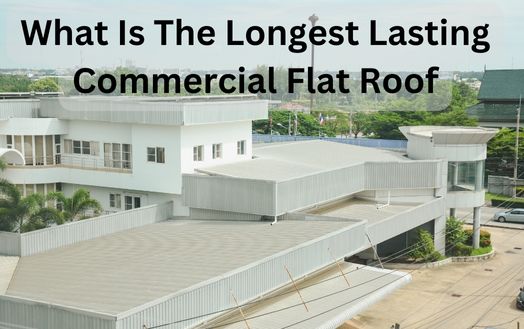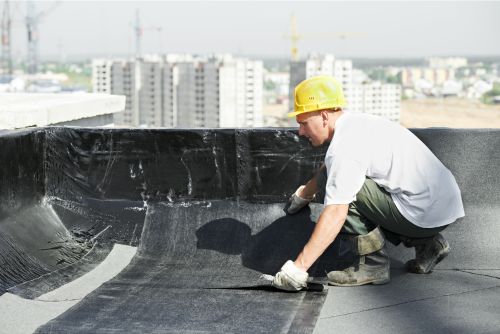
When it comes to commercial buildings, having a reliable and long-lasting flat roof is of utmost importance. A well-constructed commercial flat roof not only protects the structure beneath it but also provides peace of mind to building owners. Understanding the various types of commercial flat roofing systems, their differences, and choosing the best material for longevity are crucial factors to consider. In this blog, we will explore the different types of commercial flat roofing systems, identify what is the longest lasting commercial flat roof, maintenance requirements, and identify the longest lasting commercial flat roof.
Commercial flat roofing systems are different from traditional sloped roofs commonly found on residential buildings. They are specifically designed for commercial buildings, offering a practical and cost-effective solution for structures of any size. These flat roofs have a low slope or no slope at all, making them ideal for commercial buildings with large surface areas. Commercial flat roofs typically consist of multiple layers of materials that work together to provide a weatherproof barrier, excellent insulation, and protection against foot traffic.
Commercial flat roofing systems play a significant role in protecting commercial buildings from various weather conditions, including rain, snow, and extreme temperatures. These roofs are designed to withstand foot traffic, ensuring the safety of maintenance personnel and servicing equipment. Additionally, commercial flat roofs offer excellent insulation properties, helping to regulate the indoor temperature and reduce energy costs. The installation process of commercial flat roofs is efficient, ensuring minimal disruption to business operations. Overall, commercial flat roofing systems provide peace of mind to building owners, knowing that their investment is well-protected. It lessens the burden for any commercial roof repair NJ.
Compared to traditional sloped roofs, commercial flat roofs have several distinct differences. Firstly, flat roofs are suitable for commercial buildings of any size, from small retail outlets to large industrial complexes. The materials used in commercial flat roofs are specifically designed to withstand the unique challenges faced by commercial buildings, such as foot traffic and weather conditions. Unlike sloped roofs, which have a higher risk of commercial leak repair NJ, flat roofs offer a more cost-effective solution with reduced maintenance costs over time. Additionally, commercial flat roofing systems are tailored to meet individual building needs, allowing for customization and efficient installation.

There are several types of commercial flat roofing systems available, each with its own advantages and disadvantages. These roofing systems come in various materials, including EPDM, TPO, PVC, BUR, and metal. Understanding the differences between these materials and what is the longest lasting commercial flat roof for your option. Let’s explore each type of commercial flat roofing system in more detail.
EPDM roofing systems, short for ethylene propylene diene terpolymer, are highly durable and popular for flat roofs. These roofs are made of synthetic rubber materials, which are resistant to weather conditions, UV rays, and foot traffic. EPDM roofs are known for their long-lasting performance, providing excellent insulation and protection for commercial buildings. The installation process of EPDM roofing systems is efficient and long-lasting, ensuring a reliable roof for many years. With its excellent durability and insulation properties, EPDM roofing systems are a great choice for commercial flat roofs.
TPO roofing systems, or thermoplastic polyolefin, have gained popularity in recent years due to their excellent performance and energy efficiency. These roofing systems consist of TPO membranes, which are designed to withstand UV rays, weather conditions, and foot traffic. TPO roofs provide great insulation, contributing to energy savings for commercial buildings. The installation process of TPO roofs is relatively quick and efficient, making them a preferred choice for many building owners. With their high weather resistance and energy efficiency, TPO roofing systems offer peace of mind and long-term performance for commercial flat roofs.
PVC roofing systems, made of polyvinyl chloride, are known for their durability and long-lasting performance. These roofing systems provide excellent protection against weather conditions, UV rays, and foot traffic, making them ideal for commercial flat roofs. PVC roofs offer great insulation properties, helping to regulate the indoor temperature and reduce energy costs. The installation process of PVC roofing systems is tailored to meet the specific needs of each building, ensuring a reliable and long-lasting roof. With their excellent durability and insulation, PVC roofing systems are a popular choice for commercial flat roofs.
BUR flat roofs, short for Built-Up Roofing, consist of multiple layers of bitumen and asphalt, providing excellent durability and weatherproofing properties. These roofing systems are a cost-effective choice for commercial buildings, offering long-lasting performance and insulation.
Metal roofing systems are highly durable and long-lasting, making them a popular choice for commercial flat roofs. Metal roofs offer excellent protection against weather conditions, UV rays, and foot traffic, ensuring the long-term performance of commercial buildings. The installation process of metal roofs is efficient and long-lasting, providing a reliable roof for many years. Metal roofing systems offer peace of mind to building owners, knowing that their investment is well-protected. With their durability, longevity, and excellent insulation properties, metal roofs are a great choice for commercial flat roofs.

Choosing the best material for your commercial flat roof is a crucial decision. The material you select will impact the longevity, durability, and cost-effectiveness of your roof. Factors such as weather conditions, installation process, maintenance costs, and environmental impact should be considered when making this decision. In the next sections, we will explore the longevity and durability of each material, their cost effectiveness, and the environmental impact of various commercial flat roofing materials.
Different flat roofing systems offer varying lifespans and durability, depending on the material used and the type of system installed. It’s important to assess the long-term performance of each material when choosing what is the longest lasting commercial flat roof. Understanding the factors that contribute to longevity, such as weather conditions, installation quality, and regular maintenance, is crucial for making an informed decision. Building owners should prioritize a material that offers the desired durability, longevity, and peace of mind, ensuring that their commercial flat roof will withstand the test of time.
Cost effectiveness is an essential factor to consider when selecting a material for your commercial flat roof. While some materials may have higher initial costs, they might prove to be more cost effective in the long run due to their longevity and lower maintenance costs. Evaluating the maintenance and repair costs of each material over its lifespan is crucial for determining cost effectiveness. Synthetic rubber, modified bitumen, and metal roofing systems are known for their long-lasting performance, which justifies their higher price. Consider the maintenance costs, energy efficiency, and longevity of each material to make an informed decision for your commercial flat roof.
The environmental impact of commercial flat roof materials is an important consideration in today’s eco-conscious world. Some materials offer excellent insulation properties, reducing energy consumption and contributing to a building’s overall energy efficiency. Ethylene propylene diene terpolymer (EPDM) roofs, for example, are known for their environmental benefits, longevity, and excellent insulation. By choosing roofing materials with minimal environmental impact, building owners can contribute to sustainability practices while enjoying the long-term benefits of their commercial flat roofs. Understanding the environmental impact of each material ensures that your commercial flat roof aligns with green building practices.

Regular maintenance and care are essential for maximizing the lifespan of your commercial flat roof, as well as reducing long-term maintenance costs. By implementing a maintenance plan and conducting regular inspections, building owners can identify and address issues before they become major problems. Regular maintenance tasks include clearing debris, inspecting the roof surface, applying appropriate sealants, and addressing foot traffic impact. Prioritizing regular maintenance ensures the durability, longevity, and performance of your commercial flat roof, providing peace of mind and protecting your investment.
Scheduling regular inspections is crucial for maintaining the health of your commercial flat roof. Inspections allow for the early detection of any damage or degradation of flat roofing materials, potentially saving you from costly repairs or premature commercial roof replacement NJ. Regular inspections provide peace of mind, knowing that your roof is in good condition and protected against potential issues. By prioritizing regular inspections, building owners can address maintenance needs promptly, maximize the lifespan of their commercial flat roof, and ensure uninterrupted operations.
Regular maintenance tasks play a vital role in extending the life of your commercial flat roof. These tasks include:
When it comes to commercial flat roofs, durability and longevity are of utmost importance. Several factors influence the lifespan of a flat roof, including weather conditions, UV rays, installation quality, maintenance, and material choice. By considering these factors, building owners can identify the longest lasting commercial flat roof for their specific needs. In the following sections, we will explore the factors influencing flat roof lifespan and provide real-life examples of long-lasting commercial flat roofs, showcasing the effectiveness of specific roofing materials.
Several factors influence the lifespan of a flat roof, and understanding them is crucial for selecting the most long-lasting commercial flat roofing material. Factors to consider include:
Examining real-life examples of long-lasting commercial flat roofs offers insights into the practical application and performance of specific roofing materials. Some buildings, even after many years, have successfully maintained their commercial flat roofs, showcasing the longevity of certain roofing systems. These examples demonstrate the effectiveness of roofing materials in various weather conditions, their insulation properties, and their ability to withstand foot traffic. Observing these real-life examples can guide building owners in selecting the most appropriate material for their commercial flat roofs, ultimately ensuring long-term performance and durability.

Extending the life of your commercial flat roof is crucial for reducing maintenance costs and increasing its durability. Consider the following steps to maximize the lifespan of your roof:
Professional roofing services play a vital role in ensuring the longevity and performance of your commercial flat roof. By utilizing the expertise of roofing professionals, building owners can benefit from:
Knowing when to replace your commercial flat roof is essential for maintaining its longevity and avoiding costly repairs. Consider the following factors when determining if roof replacement is necessary:
Regular maintenance is crucial for the long-term performance of commercial flat roofs. Neglecting maintenance can lead to costly repairs, premature roof replacement, and disruptions to business operations. Here’s why regular maintenance is essential:
In conclusion, choosing the right material and properly maintaining your commercial flat roof are crucial for maximizing its lifespan. EPDM, TPO, PVC, BUR, and metal roofing systems are all viable options, each with their own unique benefits and considerations. Factors such as durability, cost-effectiveness, and environmental impact should be taken into account when making your decision. Regular inspections and essential maintenance tasks are essential for identifying and addressing any issues before they escalate. By investing in professional roofing services and knowing when to consider roof replacement, you can ensure the longevity of your commercial flat roof. Remember, regular maintenance is key to avoiding costly repairs and extending the life of your roof.